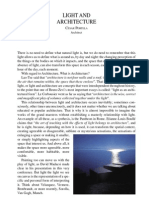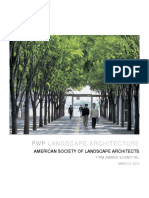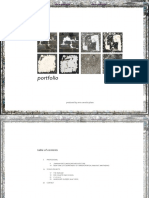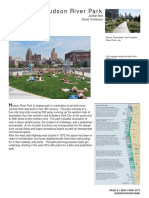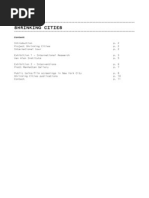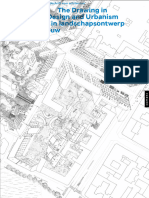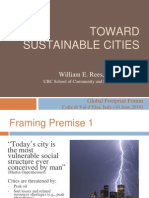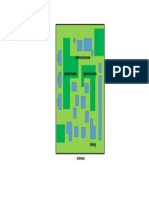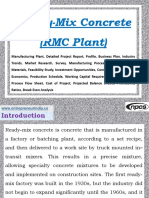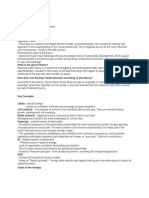0 ratings0% found this document useful (0 votes)
175 viewsForm and Fabric in Landscape Architecture
Form and Fabric in Landscape Architecture
Uploaded by
Harshada HikareThis book provides a visual and spatial framework for understanding the key elements that make up landscapes. It explores concepts like landscape fabric, spaces, paths, edges, foci, thresholds and details. The book uses clear illustrations and diagrams to explain how these basic forms come together to create an integrated landscape structure. It is intended as an introduction for students and a reference for experienced designers to develop strong visual-spatial thinking and awareness of landscape design principles.
Copyright:
© All Rights Reserved
Available Formats
Download as DOCX, PDF, TXT or read online from Scribd
Form and Fabric in Landscape Architecture
Form and Fabric in Landscape Architecture
Uploaded by
Harshada Hikare0 ratings0% found this document useful (0 votes)
175 views1 pageThis book provides a visual and spatial framework for understanding the key elements that make up landscapes. It explores concepts like landscape fabric, spaces, paths, edges, foci, thresholds and details. The book uses clear illustrations and diagrams to explain how these basic forms come together to create an integrated landscape structure. It is intended as an introduction for students and a reference for experienced designers to develop strong visual-spatial thinking and awareness of landscape design principles.
Original Description:
Book on Landscape Architecture
Copyright
© © All Rights Reserved
Available Formats
DOCX, PDF, TXT or read online from Scribd
Share this document
Did you find this document useful?
Is this content inappropriate?
This book provides a visual and spatial framework for understanding the key elements that make up landscapes. It explores concepts like landscape fabric, spaces, paths, edges, foci, thresholds and details. The book uses clear illustrations and diagrams to explain how these basic forms come together to create an integrated landscape structure. It is intended as an introduction for students and a reference for experienced designers to develop strong visual-spatial thinking and awareness of landscape design principles.
Copyright:
© All Rights Reserved
Available Formats
Download as DOCX, PDF, TXT or read online from Scribd
Download as docx, pdf, or txt
0 ratings0% found this document useful (0 votes)
175 views1 pageForm and Fabric in Landscape Architecture
Form and Fabric in Landscape Architecture
Uploaded by
Harshada HikareThis book provides a visual and spatial framework for understanding the key elements that make up landscapes. It explores concepts like landscape fabric, spaces, paths, edges, foci, thresholds and details. The book uses clear illustrations and diagrams to explain how these basic forms come together to create an integrated landscape structure. It is intended as an introduction for students and a reference for experienced designers to develop strong visual-spatial thinking and awareness of landscape design principles.
Copyright:
© All Rights Reserved
Available Formats
Download as DOCX, PDF, TXT or read online from Scribd
Download as docx, pdf, or txt
You are on page 1of 1
walks the reader
h points and lines,
que.with hierarchy This book is a great visual and morphological resource of elements within the landscape.The layout
of the book alongside the graphic content gives a great visual references. This layout helps the
dents, I believe it's
designer to make a connection and create a visual and spatial narrative of the elements that
to me. creates the landscape.It provides an original, visual approach to the study of landscape
architecture by creating a spatial morphology based on use and experience of landscapes. It
of very basic forms explores aesthetic, spatial and experiential concepts by providing a structure through which
s and dimensional landscapes can be understood and conceived in design. 'Fabric' is the integrated structure of
tion, architect and whole landscapes, while 'form' refers to the components that make up this fabric. Together form
h the centuries. He and fabric create a morphology of landscape useful for the development of visual-spatial design
the principles in
thinking and awareness. This book is intended as both an introduction to the discipline for
students of landscape architecture, architecture and planning, and a source of continuing interest
all hangs together for more experienced environmental designers.The book is divided into seven chapters:
s of varying quality 1-Landscape Fabric 2-Spaces 3-Paths 4-Edges 5-Foci 6-Thresholds 7-Detail. With the great visual
h all the flat plans layout and description of the terms this book not only can be used as a source to be used into
understanding the different elements within the landscape it also could be used as a source to
build the necessary vocabulary for the design student.The organization of the chapters is in a way
the subject. Often
that helps the student build the spatial and visual elements of the landscape and enables them to
understanding the
love the way that
build and integrate these elements into their work.Landscape architecture involves the spatial
ite example; "The organisation of outdoor places to meet human needs and desires while protecting or enhancing
al volume, mark off natural environments and processes.Landscapesusuallyneedtofunctionindiverse ways for different
blish a measurable people. The designer aims to create places that meet social, environmental, cultural, aesthetic and
atial dimensions practical requirements. This book is intended both as an introduction to the discipline of
landscape architecture and also a source of continuing interest for more experienced
environmental designers.
d of nearly perfect
asp some of the
This is a book for those interested in the practical philosophy of landscape architecture. It is not
ral principles is a only the discussion by the author, but also the author's illustrations which reinforce her extremely
gn education. This valuable insights into form and complexity. I use the book as an exercise for sketching. She is right,
book if any of us sketching is perception.
y informative, easy
our design career.
, illustrations, and
n to improve your
creation done by
day i apply these
me as I found it
built environment
my ideal as it has
ructures and their
You might also like
- Tadao - Ando Mrduljaš Real and ImaginaryDocument12 pagesTadao - Ando Mrduljaš Real and ImaginarymmrduljasNo ratings yet
- Balancing The 16 ChakrasDocument11 pagesBalancing The 16 ChakrasVictor Rodrigues92% (13)
- Must Landscapes Mean?: Approaches To Significance in Recent Landscape Architecture. Marc TreibDocument17 pagesMust Landscapes Mean?: Approaches To Significance in Recent Landscape Architecture. Marc TreibMario G,omezNo ratings yet
- Andscapes Concepts of Nature and Culture For Landscape Architecture in The AnthropoceneDocument15 pagesAndscapes Concepts of Nature and Culture For Landscape Architecture in The AnthropoceneAlejandro SanchezNo ratings yet
- Light & Architecture - Cesar PortelaDocument4 pagesLight & Architecture - Cesar PortelaCristina MunteanuNo ratings yet
- James Coleman's Foundations of Social TheoryDocument25 pagesJames Coleman's Foundations of Social TheoryHaneefa MuhammedNo ratings yet
- (Univocal) Gilbert Simondon, Drew S. Burk-Two Lessons On Animal and Man-Univocal Publishing (2012)Document89 pages(Univocal) Gilbert Simondon, Drew S. Burk-Two Lessons On Animal and Man-Univocal Publishing (2012)Romero Ramero100% (1)
- Muir Mapping Landscape UrbanismDocument164 pagesMuir Mapping Landscape UrbanismNoel Murphy100% (3)
- Layers in LandscapeDocument11 pagesLayers in LandscapeAkash SrivastavaNo ratings yet
- Rethinking Urban Landscape Secchi 2007Document6 pagesRethinking Urban Landscape Secchi 2007Jose F. Rivera SuarezNo ratings yet
- Basic Techniques For Typomorphological Urban AnalysisDocument11 pagesBasic Techniques For Typomorphological Urban AnalysishesyNo ratings yet
- Landscape 2012 UkDocument19 pagesLandscape 2012 UkHaru RazziatiNo ratings yet
- 2014 - Landscape Planning A Brief History of Influential Ideas - Carl SteinitzDocument8 pages2014 - Landscape Planning A Brief History of Influential Ideas - Carl SteinitzBoris RadicNo ratings yet
- Urban Space-Robert Schafer PDFDocument13 pagesUrban Space-Robert Schafer PDFgiljermoNo ratings yet
- Architects-Behaving-Badly3 Harvard Design MagazineDocument3 pagesArchitects-Behaving-Badly3 Harvard Design MagazineJelena SavicNo ratings yet
- Landscape Design Methods in Architecture PDFDocument14 pagesLandscape Design Methods in Architecture PDFY GaoNo ratings yet
- Nijhuis 2013 Digital Media in Landscape ArchitectureDocument14 pagesNijhuis 2013 Digital Media in Landscape Architectureexe100% (1)
- Landscape ArchitectsDocument12 pagesLandscape ArchitectsRonald TangNo ratings yet
- Recent Trends in Modern Urban Concept of Landscape Design PDFDocument17 pagesRecent Trends in Modern Urban Concept of Landscape Design PDFhadiNo ratings yet
- Landscape and LandschaftDocument1 pageLandscape and LandschaftThiagoNo ratings yet
- PWP LandscapeDocument29 pagesPWP LandscapeAnthony GeorgeNo ratings yet
- Molly Hendry-The Garden ProjectDocument65 pagesMolly Hendry-The Garden ProjectStudioAPLA100% (1)
- Corner LandscapeDocument22 pagesCorner LandscapeJOHNATIELNo ratings yet
- Theocritus and Things (Lilah Grace Canevaro) (Z-Library)Document250 pagesTheocritus and Things (Lilah Grace Canevaro) (Z-Library)Susana AguirreNo ratings yet
- Hundred Best Books On Landscape ArchitectureDocument3 pagesHundred Best Books On Landscape ArchitectureSchumarcinaNo ratings yet
- Post Modernist Gardens - FinalDocument31 pagesPost Modernist Gardens - FinalAr Deyvanai KannanNo ratings yet
- CORBOZ - The Land As PalimpsestDocument23 pagesCORBOZ - The Land As PalimpsestFabrizio BallabioNo ratings yet
- Landscape Architecture PortfolioDocument25 pagesLandscape Architecture PortfolioAnna PauletteNo ratings yet
- Hudson River Park: Jordan Bell David TomlinsonDocument13 pagesHudson River Park: Jordan Bell David TomlinsonInduShajiNo ratings yet
- Shrinking Cities ProjectDocument11 pagesShrinking Cities ProjectDragan Krstevski GagoNo ratings yet
- Whats Landscape, The Language of Landscape, Anne WhistonsSpirnDocument12 pagesWhats Landscape, The Language of Landscape, Anne WhistonsSpirnohoudNo ratings yet
- Rowe Koetter - Collage CityDocument27 pagesRowe Koetter - Collage CityJuliana Trujillo100% (1)
- Advances Landscape Architecture I To 13Document935 pagesAdvances Landscape Architecture I To 13chinchay07100% (1)
- Landscape Final 1Document81 pagesLandscape Final 1عمر رائد مشتهى احمدNo ratings yet
- From Motherearth PDFDocument23 pagesFrom Motherearth PDFDadalambadaNo ratings yet
- Climate and VegetationDocument82 pagesClimate and VegetationsereneNo ratings yet
- Principles of Landscape DesignDocument29 pagesPrinciples of Landscape DesignSakshi RawatNo ratings yet
- Planning & Designing Green School GroundsDocument64 pagesPlanning & Designing Green School Groundsmohammed hassainNo ratings yet
- Busquets 2006 City X Lines Ch0 IntroductionDocument7 pagesBusquets 2006 City X Lines Ch0 IntroductionNeil Simpson100% (1)
- Landscape ArchitectureDocument9 pagesLandscape Architecturelisan2053No ratings yet
- OASE 107 (2020), The Drawing in Landscape Design and UrbanismDocument78 pagesOASE 107 (2020), The Drawing in Landscape Design and UrbanismAlexandra Mera100% (1)
- 2017 University and College Brochure - Web PDFDocument62 pages2017 University and College Brochure - Web PDFIbrahimMehmedagić100% (1)
- Ruskin, John The Seven Lamps of Architecture 1849 PDFDocument269 pagesRuskin, John The Seven Lamps of Architecture 1849 PDFVivienne KangNo ratings yet
- Space Conceived Through Natural Beauty It Is About Style It Is About EnigmaDocument47 pagesSpace Conceived Through Natural Beauty It Is About Style It Is About EnigmaKrishna KriShNo ratings yet
- Toward Sustainable Cities: William E. Rees, PHD, FRSCDocument16 pagesToward Sustainable Cities: William E. Rees, PHD, FRSCcivilsociety3058No ratings yet
- Density & Atmosphere On Factors Relating To Buildi... - (DENSITY ANALYSES)Document184 pagesDensity & Atmosphere On Factors Relating To Buildi... - (DENSITY ANALYSES)ahceratiNo ratings yet
- Landscape ArchitectureDocument209 pagesLandscape ArchitectureTerinte Roxana StefaniaNo ratings yet
- Parc de La VilletteDocument5 pagesParc de La VilletteShivaniNo ratings yet
- Asian Design in LandscapingDocument3 pagesAsian Design in LandscapingNorberto R. BautistaNo ratings yet
- Timeless Way of Building:: An Examination of The Universal StepsDocument19 pagesTimeless Way of Building:: An Examination of The Universal StepsGurpal KaurNo ratings yet
- Urbanism, Landscape, Ecology - Harvard Graduate School of DesignDocument9 pagesUrbanism, Landscape, Ecology - Harvard Graduate School of DesignSantiago LorenzoNo ratings yet
- Leon Krier - Urban ComponentsDocument18 pagesLeon Krier - Urban ComponentsWalL's Badillo Jiménez100% (1)
- 2008 Gsd4401 Transparency SyllabusDocument4 pages2008 Gsd4401 Transparency SyllabusrajyamgarNo ratings yet
- Rob Krier - Town SpacesDocument3 pagesRob Krier - Town SpacesSuraj WankhedeNo ratings yet
- The Accidental Playground: Brooklyn Waterfront Narratives of the Undesigned and UnplannedFrom EverandThe Accidental Playground: Brooklyn Waterfront Narratives of the Undesigned and UnplannedNo ratings yet
- Rural Architecture: Being a Complete Description of Farm Houses, Cottages, and Out BuildingsFrom EverandRural Architecture: Being a Complete Description of Farm Houses, Cottages, and Out BuildingsNo ratings yet
- The Rite of Urban Passage: The Spatial Ritualization of Iranian Urban TransformationFrom EverandThe Rite of Urban Passage: The Spatial Ritualization of Iranian Urban TransformationNo ratings yet
- New Doc 2019-12-13 10.21.18Document2 pagesNew Doc 2019-12-13 10.21.18Harshada HikareNo ratings yet
- New Doc 2020-03-12 15.04.04 - 20200312152544Document2 pagesNew Doc 2020-03-12 15.04.04 - 20200312152544Harshada HikareNo ratings yet
- Root ZoneDocument9 pagesRoot ZoneHarshada HikareNo ratings yet
- New Doc 2020-03-12 15.02.25 - 20200312152607Document2 pagesNew Doc 2020-03-12 15.02.25 - 20200312152607Harshada HikareNo ratings yet
- 2.types of Plywood PDFDocument8 pages2.types of Plywood PDFHarshada HikareNo ratings yet
- Root ZoneDocument9 pagesRoot ZoneHarshada Hikare0% (1)
- Old AgeDocument1 pageOld AgeHarshada HikareNo ratings yet
- Root ZoneDocument9 pagesRoot ZoneHarshada Hikare0% (1)
- Ready-Mix Concrete (RMC Plant) - 627631 PDFDocument84 pagesReady-Mix Concrete (RMC Plant) - 627631 PDFHarshada Hikare100% (1)
- Living in Old Age For Old PeopleDocument40 pagesLiving in Old Age For Old PeopleHarshada HikareNo ratings yet
- Sustainable Hospital Buildings PDFDocument115 pagesSustainable Hospital Buildings PDFHarshada HikareNo ratings yet
- GATE Architecture Study Material Book 1 Architecture and Design PDFDocument20 pagesGATE Architecture Study Material Book 1 Architecture and Design PDFHarshada HikareNo ratings yet
- Symbiosis: Standard Operating Procedure (SOP) For HostelDocument15 pagesSymbiosis: Standard Operating Procedure (SOP) For HostelHarshada Hikare100% (1)
- ESIO Trot Unit-Leanne WilliamsonDocument17 pagesESIO Trot Unit-Leanne WilliamsonS TANCRED100% (2)
- Questionnaire About MotivationDocument3 pagesQuestionnaire About Motivationapi-285641461No ratings yet
- Are You A Colloborative LeaderDocument14 pagesAre You A Colloborative LeaderShubhrayan DasguptaNo ratings yet
- Chaudhry Ranbir Singh: A Short Political Biography.Document138 pagesChaudhry Ranbir Singh: A Short Political Biography.Ranbir Singh ChaudhryNo ratings yet
- African DramaDocument15 pagesAfrican DramaMichelle RangesNo ratings yet
- Certificate of Travel CompletedDocument1 pageCertificate of Travel CompletedJP BotorNo ratings yet
- The Mindsets 5Document1 pageThe Mindsets 5mojtaba.nezhadkoorkiNo ratings yet
- Domination in GraphsDocument6 pagesDomination in GraphsJunel Alapa100% (1)
- Maa BookDocument3 pagesMaa BookSrijan VermaNo ratings yet
- CaesuraDocument21 pagesCaesuram54237No ratings yet
- Rothschild Alien Connect Needing To Be in Possession of Jerusalem Niburu Alien Mission Control CenterDocument2 pagesRothschild Alien Connect Needing To Be in Possession of Jerusalem Niburu Alien Mission Control CenterFrank GallagherNo ratings yet
- Vries - Tantalisingly Close - Archaeology of Communication PDFDocument217 pagesVries - Tantalisingly Close - Archaeology of Communication PDFEdgardo DielekeNo ratings yet
- Jsaquin - Friction - IplanDocument4 pagesJsaquin - Friction - IplanJames Arvin SaquinNo ratings yet
- Psychoanalytic ReportDocument3 pagesPsychoanalytic ReportMa Elpha Rhea DungganonNo ratings yet
- 2010 Letter To My Son Reading GuideDocument2 pages2010 Letter To My Son Reading GuideYolo DoeeNo ratings yet
- NEVILLE Marking GenderDocument22 pagesNEVILLE Marking GenderThom EmNo ratings yet
- CAPDocument14 pagesCAPMayleth BoadillaNo ratings yet
- Ethical Teaching of IMMANUEL KANTDocument24 pagesEthical Teaching of IMMANUEL KANTloveleeNo ratings yet
- Temporal Motivation Theory: Core Theory of The Procrastination EquationDocument5 pagesTemporal Motivation Theory: Core Theory of The Procrastination EquationFirst Lastppgi100% (1)
- Dead Poets Society Reflection PaperDocument1 pageDead Poets Society Reflection PaperCHARLES RONALD GENATONo ratings yet
- 7 Ways To Cultivate Strong Determination With Vajra Nadi and 114 ChakrasDocument6 pages7 Ways To Cultivate Strong Determination With Vajra Nadi and 114 Chakrass.roha669No ratings yet
- Sri Rudra TrisatiDocument8 pagesSri Rudra TrisatiNatarajan IyerNo ratings yet
- Doctrine of Unconscionability Its DevelopmeDocument17 pagesDoctrine of Unconscionability Its DevelopmeLenny JM100% (1)
- Q2 Week 7 21st CLDocument3 pagesQ2 Week 7 21st CLRonald RomeroNo ratings yet
- 6.5 Students - BookDocument214 pages6.5 Students - Bookbai postNo ratings yet
- Media Literacy - Sir PangilinanDocument22 pagesMedia Literacy - Sir Pangilinananonymous PhNo ratings yet
- Hatha Yoga and The Meaning of TantraDocument26 pagesHatha Yoga and The Meaning of Tantraamiitk100% (10)





